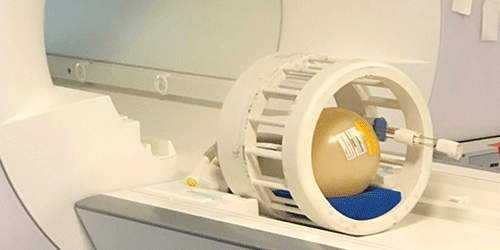A “Meta” Solution to MRI Inhomogeneities
Turning up the magnetic field in an MRI scanner could potentially help in imaging the onset of neurodegenerative diseases such as Alzheimer’s. However, ultrahigh-field MRI has stalled in its development because the radio waves that drive the MRI signal are not sufficiently uniform. A new method to control the direction of radio waves inside an MRI scanner uses a small, antenna-like metamaterial. In demonstrations, this “meta-atom” reduced radio-wave inhomogeneities in a test sample, improving the MRI signal over the background by 50 percent.
An MRI scanner uses a combination of magnetic fields and radio waves to induce coherent oscillations in magnetic spins within a tissue. Clinical MRI machines currently have magnetic fields between 1.5 and 3 T, but boosting to 7 T or more could provide greater resolution and contrast between tissues. Unfortunately, the corresponding radio waves scatter inside a biological target (like a human head) to produce unwanted bright and dark zones.
To solve this problem, a team led by researchers from the Fresnel Institute and the University of Paris, Saclay, developed a meta-atom consisting of four metal wires lined up close together. Like radio antennas, the wires can telescope from 100 cm down to 20 cm. When placed inside the tube-like structure of an MRI scanner, the meta-atom can be tuned to redirect the machine’s radio waves in a desired direction. The team tested their meta-atom by placing it a few centimeters away from a specially designed test mannequin. In MRI scans at 7 T, the meta-atom helped brighten a dark zone on the periphery of the mannequin’s head. Future work will attempt to combine multiple atoms to obtain more uniform radio coverage.
This research is published in Physical Review X.
–Michael Schirber
Michael Schirber is a Corresponding Editor for Physics based in Lyon, France.





